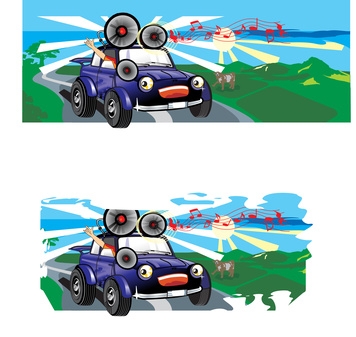
For car audio enthusiasts, a capacitor is a must for any high-powered car stereo system. Capacitors, many made in the "1.0 farad" variety, are essentially mini-batteries that charge and release energy to allow your electrical system to function as it should, even while your amplifier is drawing a great deal of power from your battery.
Disconnect the car battery. This step could save your life, so don't overlook it.
Cut a section of red wire no bigger than 3 feet. This is to connect your capacitor to the amplifier; if your capacitor is more than 3 feet from the amp, it loses effectiveness. Make sure the wire is the same size as the wire running from your car battery to your amp. For example, you don't want to have 8-gauge wire running from the amp to the battery, and then 10-gauge wire on the capacitor. Use the same size.
Attach the ring terminals to the ends of the power wire you cut. Using the wire crimpers, squeeze them until they form a seal with the wire. Give them a little tug to ensure that they can't be pulled off. You'll also want to disconnect the power wire going from the battery to the amp (at the amp).
Unscrew the bolts on the capacitor. Using the holes left by removing the bolt, add the power wire from the battery, and the section of power wire you just cut, to the positive terminal of the capacitor before screwing the bolt back on. The bolt should be tight enough to hold both wires securely.
Attach the power wire you just cut to the 12-volt power section of the amp by holding it in place and then tightening the screw or clamp on the amp that holds the wire. One side of this wire will be on the amp, the other on the capacitor. Remember: The capacitor is the go-between of the battery and the amp, so it'll always be connected in front of the amp.
Cut some black, or negative, wire and add ring terminals. Attach one end to the negative terminal of the capacitor, and ground the other end. Screw the bolt back into the negative terminal and ensure a tight fit.
To ground the wire, you'll need to ensure that it makes solid contact with metal, and doesn't move. You can ground the wire by screwing it into the wheel well of your car, which is located under the carpet in the trunk. Don't drill into the bottom of the trunk, or you risk puncturing the gas tank.
Remove the fuse from the inline fuse holder near the car battery. The fuse holder is no more than 6 inches from where the power wire was previously connected. It's easy to identify, as it'll have a piece of red wire running off the positive battery terminal, and then the fuse holder, and another piece of red wire running out the back of the fuse holder.
Insert the resistor in the fuse's place and reattach the wire to the battery. Hook up the multimeter to the capacitor (positive to positive, negative to negative), and watch until it reaches 12 volts--a large amount for a new capacitor, so charge slowly. Once it reaches 12 volts, you can remove the resistor, and reinsert the fuse. Your capacitor is now ready.
Screw the capacitor to the sub enclosure, or find another way to anchor it to your car. The more the capacitor moves, the more likely you'll run into problems, like loose wires.